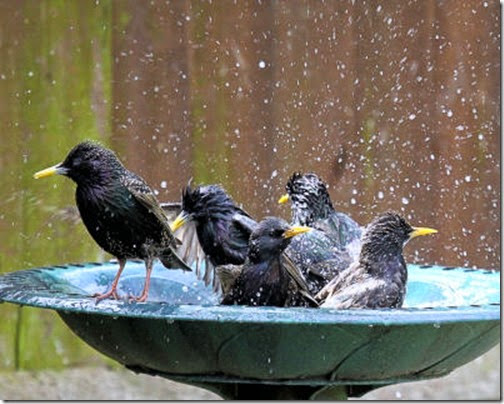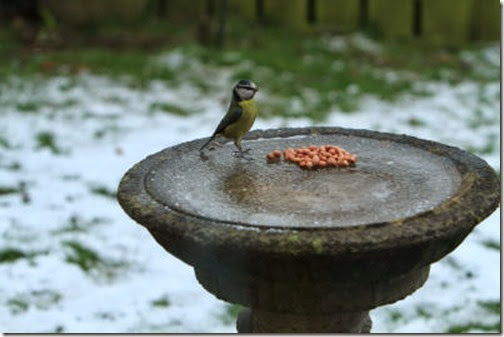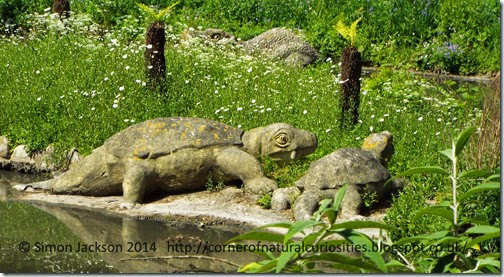In this post, you will discover how to feed birds in different ways. Not all birds feed the same way. So this means you will need to be a little creative.

Some birds, such as the blue and yellow macaw above, are happy to feed by hand (image courtesy of Khunaspix FreeDigitalPhotos.net). This post, however will focus on garden birds; birds that you can see and attract without having to go on holiday or visit the zoo.
Some garden birds, such as robins and pigeons, also feed by hand However, it is far easier to feed them, by putting food onto the ground. Some food items, such as bread and meal worm can be distributed in this way.
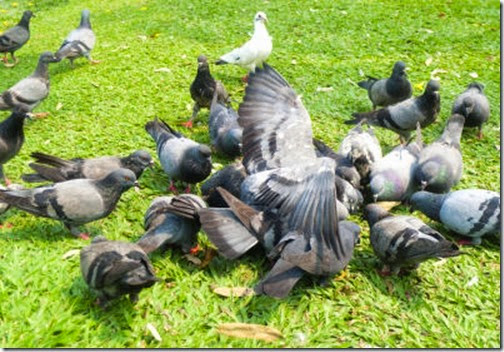
Above; feral pigeons (Columba livia) congregrate en masse on a garden lawn (image courtesy of Natara at FreeDigitalPhotos.net)
However, not all species of bird (e.g. goldfinches) like to feed on the ground. Bird tables and hanging feeders are more effective ways of distributing many food items, attracting a greater number of bird species.
Bird Tables
Distributing food items on a bird table will attract smaller species, such as robins, tits and greenfinches. Bird tables come in all shapes and sizes, though one with a roof will provide shelter for visiting bird guests. Ensure that there are no sharp edges which will harm your avian visitors.
Make sure that the bird table is a suitable height (at least a metre) above the ground and away from anything obvious that a cat could use as a platform to pounce onto the bird table and unsuspecting bird guests. If your bird table is made of wood, then by fitting an inverted plastic bucket at the top of the pole, at the base of the table platform, this should stop scaling cats and squirrels (squirrels, though they will not harm birds, have a tendency to completely raid the food bounty!). Additional tip: you will need to fit some wiremesh around the base of the bucket to stop squirrels gnawing it away.
Larger species, such as pigeons, will also try and devour everything on the table in sight, so you may like to consider winding some string around the centre, a couple of inches above the platform of the table, in order to prevent this. Alternatively, a 4 cm wiremesh around the table will also keep out the larger birds.
You also need to clean the table regularly and avoid letting old food accumulate, which will lead to the buildup of harmful bacteria.
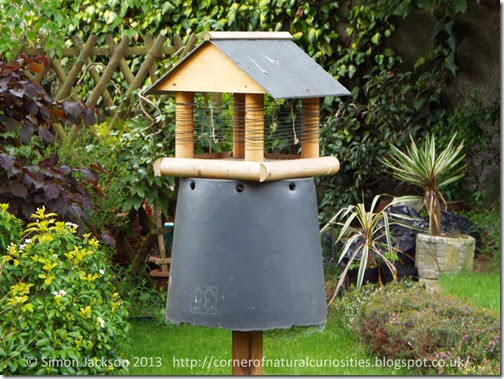
Above: A bird table, showing modifications restricting squirrel and pigeon access
'Hanging' Feeders
In my experience, hanging food feeders are a better way of attracting small birds, at least to our sub-urban garden. Because these feeders have a mesh or small access point they inherently keep out squirrels or larger birds, such as pigeons, and depending on where you live, may be a better investment than a bird table. Ideally place them on the branches of a tree, where birds would be sheltered by overhanging foliage (offering protection from both the rain and prospecting sparrow hawks).
Hanging peanut feeders consist of a wiremesh, between which dining bird guests can access the goodies via pecking. The mesh is typically about half a centimetre apart, allowing birds to get their beaks in without letting the peanuts slip out. These feeders will attract tits, greenfinches, ring-necked parakeets, and sometimes greater spotted woodpeckers.
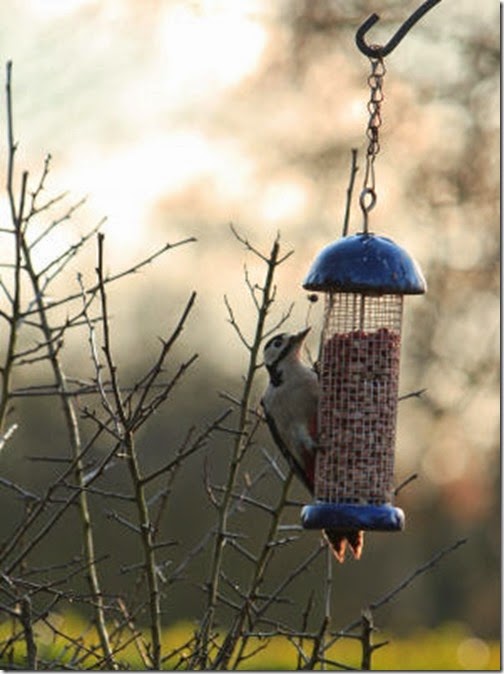
Above: greater spotted woodpecker (Dendrocopos major) feeding on peanuts (image courtesy of Tina Phillips at FreeDigitalPhoto.net)
Some specialised peanut feeders have a spring-loaded metal sheath around them, so that when prospecting squirrels land on the feeders, they inadvertently pull the sheath down around the peanuts and block their passage to them. The agility of squirrels never fails to amaze me, and they always seem to get onto the feeder no matter how far it is from the trunk of the tree — but this spring-loaded sheath always seems to do the trick and leaves the little critter more than a little disappointed.
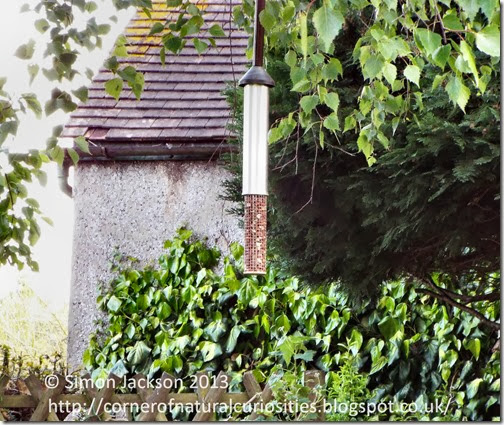
Above: A hanging peanut feeder, designed to keep squirrels out with spring-loaded sheath
Hanging seed feeders
consist of cylindrical transparent tubes which have one or more access points for the bird. They also have a platform for the bird to perch on, while they dine. Sunflower seeds can be distributed in this way (in addition to on a bird table), and it's quite common to see a tit or greenfinch leisurely sitting on the feeder while it strips the shell of the kernel.

Above: Great tit (Parus major), left, and coal tit (Periparus ater), right. (Image courtesy of Tina Phillips at FreeDigitalPhotos.net)
Nyjer seeds can be distributed through a specialised Nyjer seed feeder. Depending on how many perching points you have, you can attract several goldfinches all leisurely feeding at the same time (unless you startle them, they are happy to dine, unhurriedly, for 5, 10 minutes or more, and with their spectacular coloured plumage make a marvellous addition to your garden!)
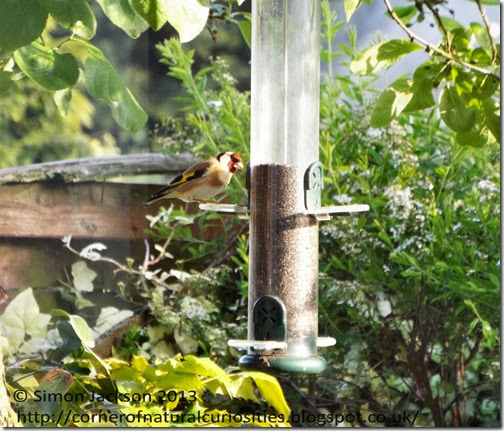
Above: A goldfinch (Carduelis carduelis) feeding on a hanging Nyjer seed feeder
Suet ball feeders consist of hanging baskets or cages, in which the food is placed. But do remember to remove the mesh packaging from the balls first, as this is harmful to birds. In our garden anyway, this food is very popular with blue tits and sometimes if we are lucky we get a large group of feeding long-tailed tits.
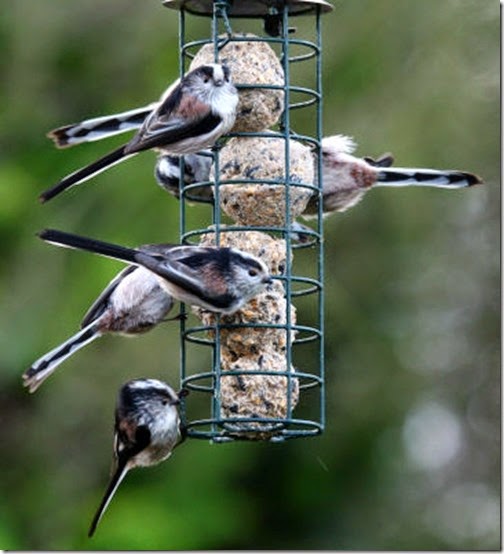
Above: Long-tailed tits (Aegithalos caudatus) feeding on suet balls (image courtesy of Paul Brentnall)
Mealworms can be dispersed via a hanging tray, which the robin is quite happy to swoop down on to grab its dinner, before immediately flying off again. However, open trays can be raided by starlings — which have the habit of consuming every last remaining scrap. Therefore, there are specialised mealworms feeders you can purchase which have adjustable height roofs, which only allow smaller birds, such as robins, in.
In the series:
Introduction
What do you feed birds?
What do birds drink?
RSPB advice
If you have already created a ‘bird garden’, you may have some useful tips of your own. Please share them through a comment.













